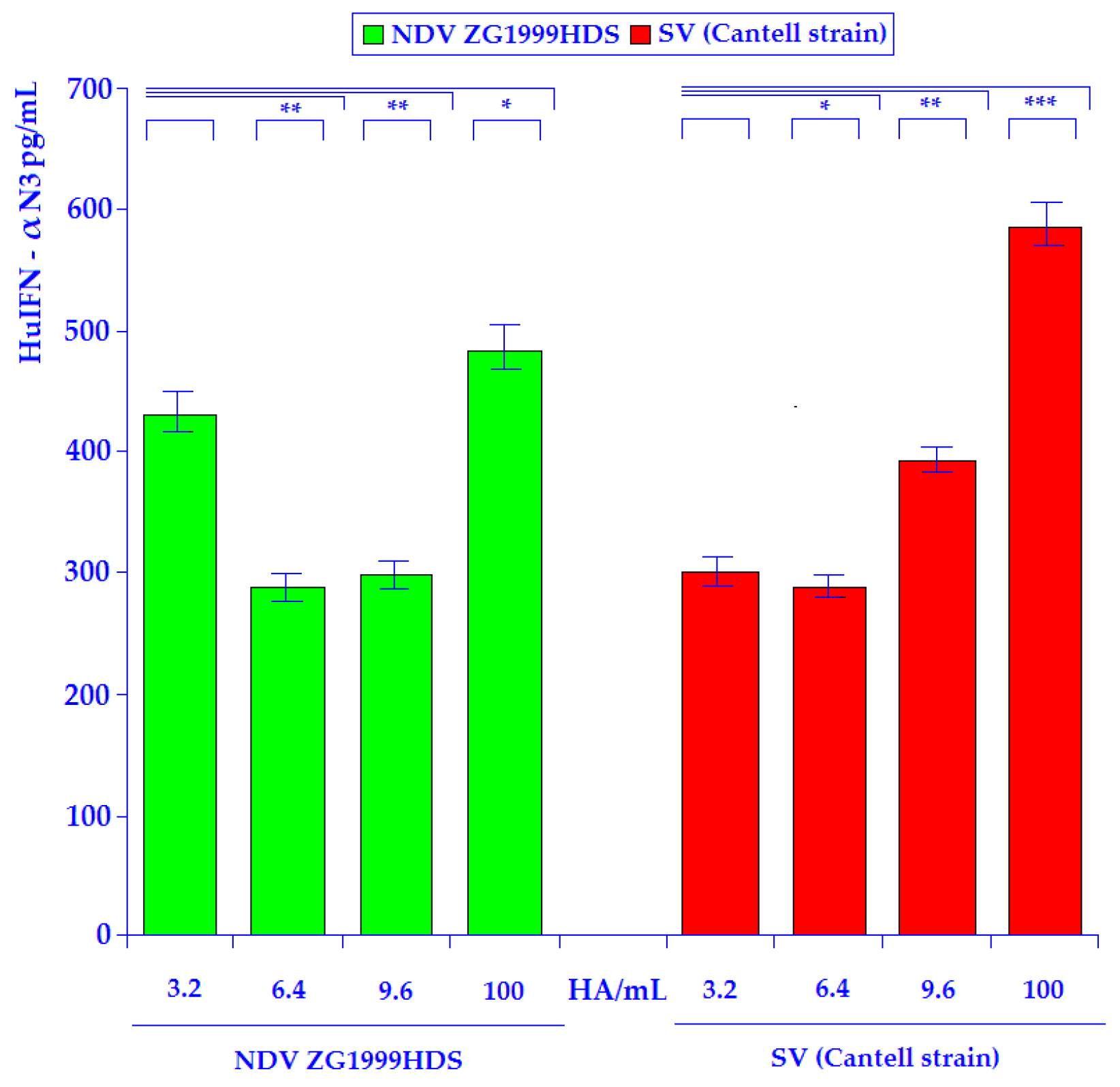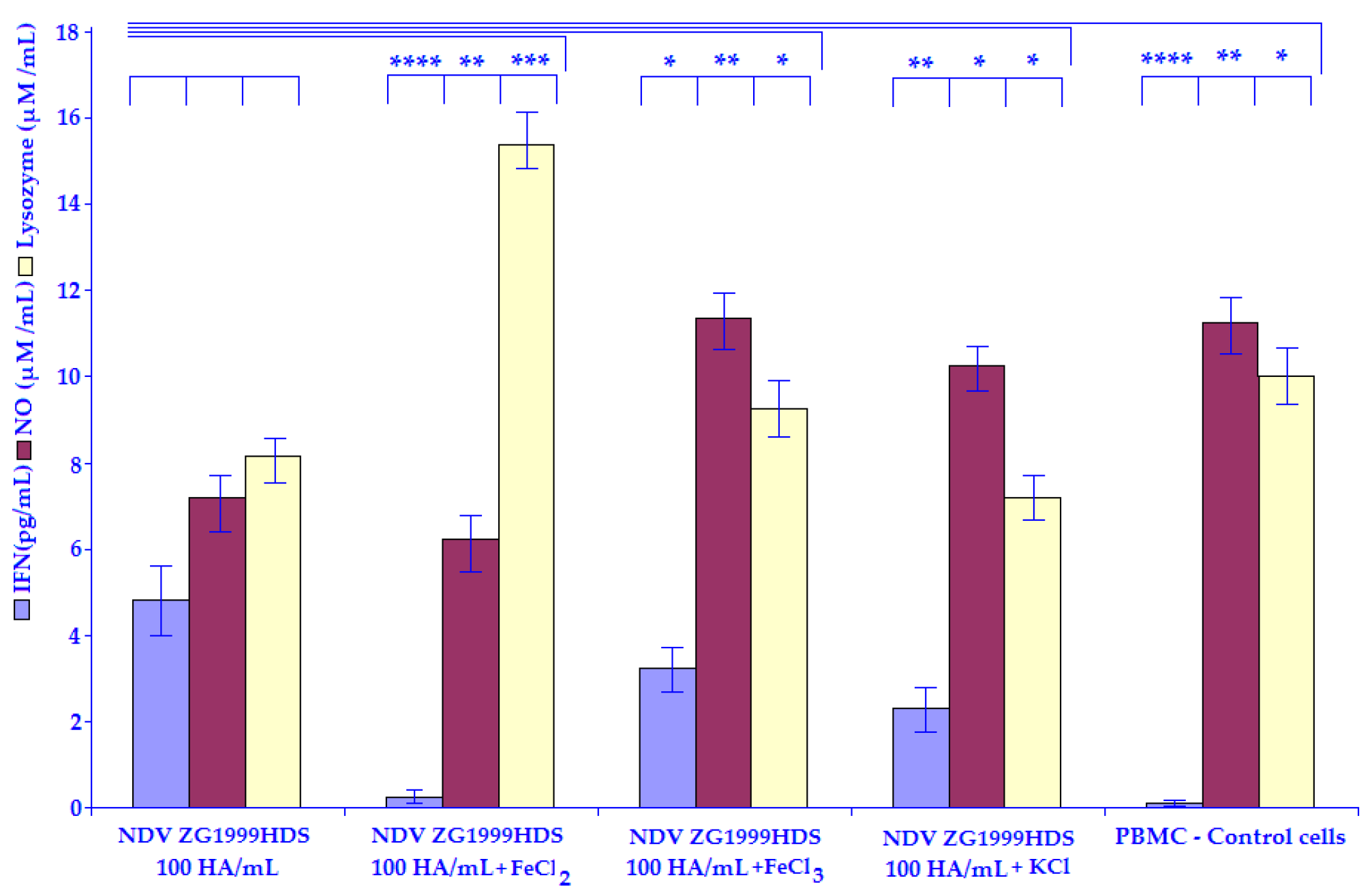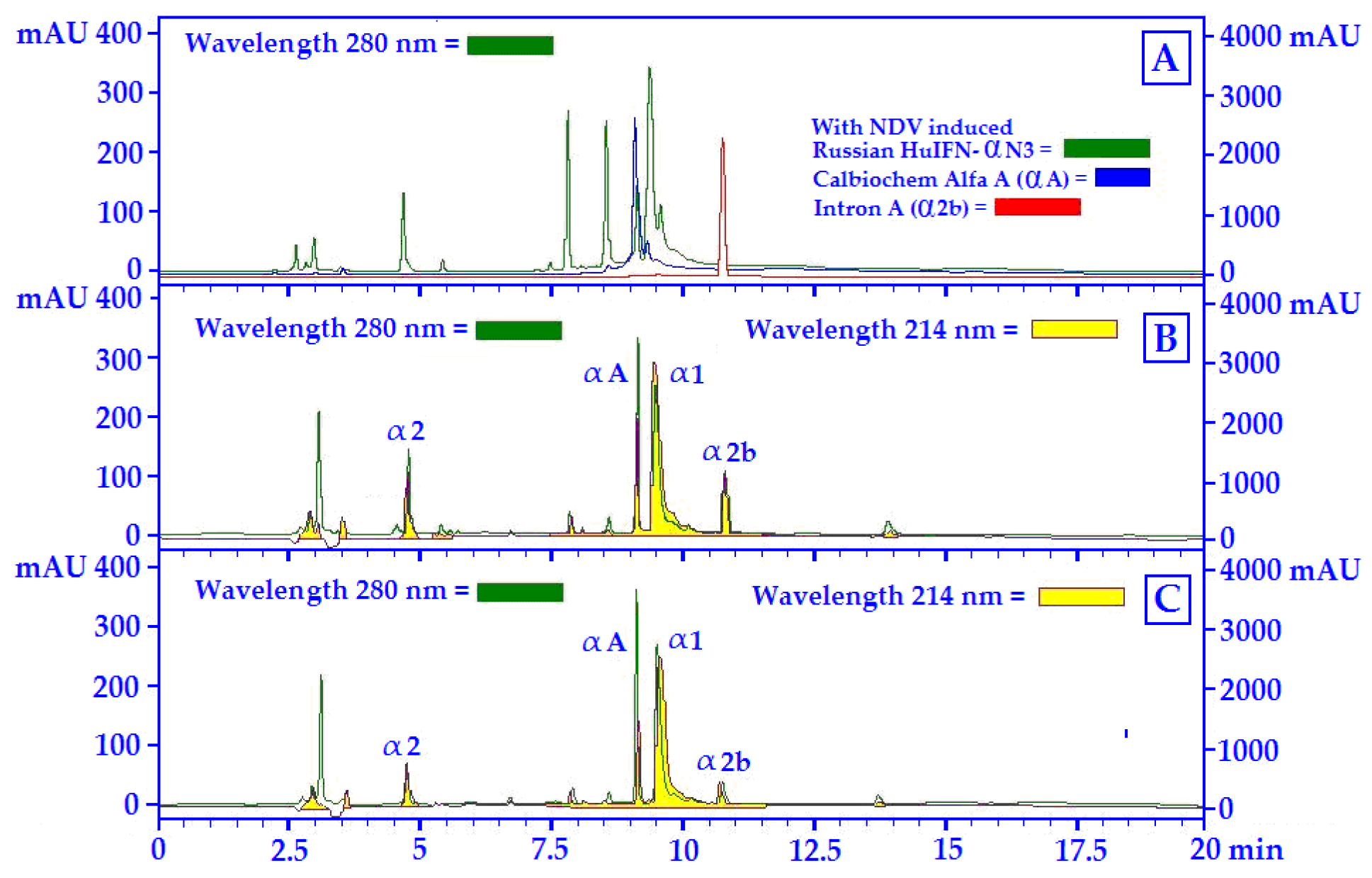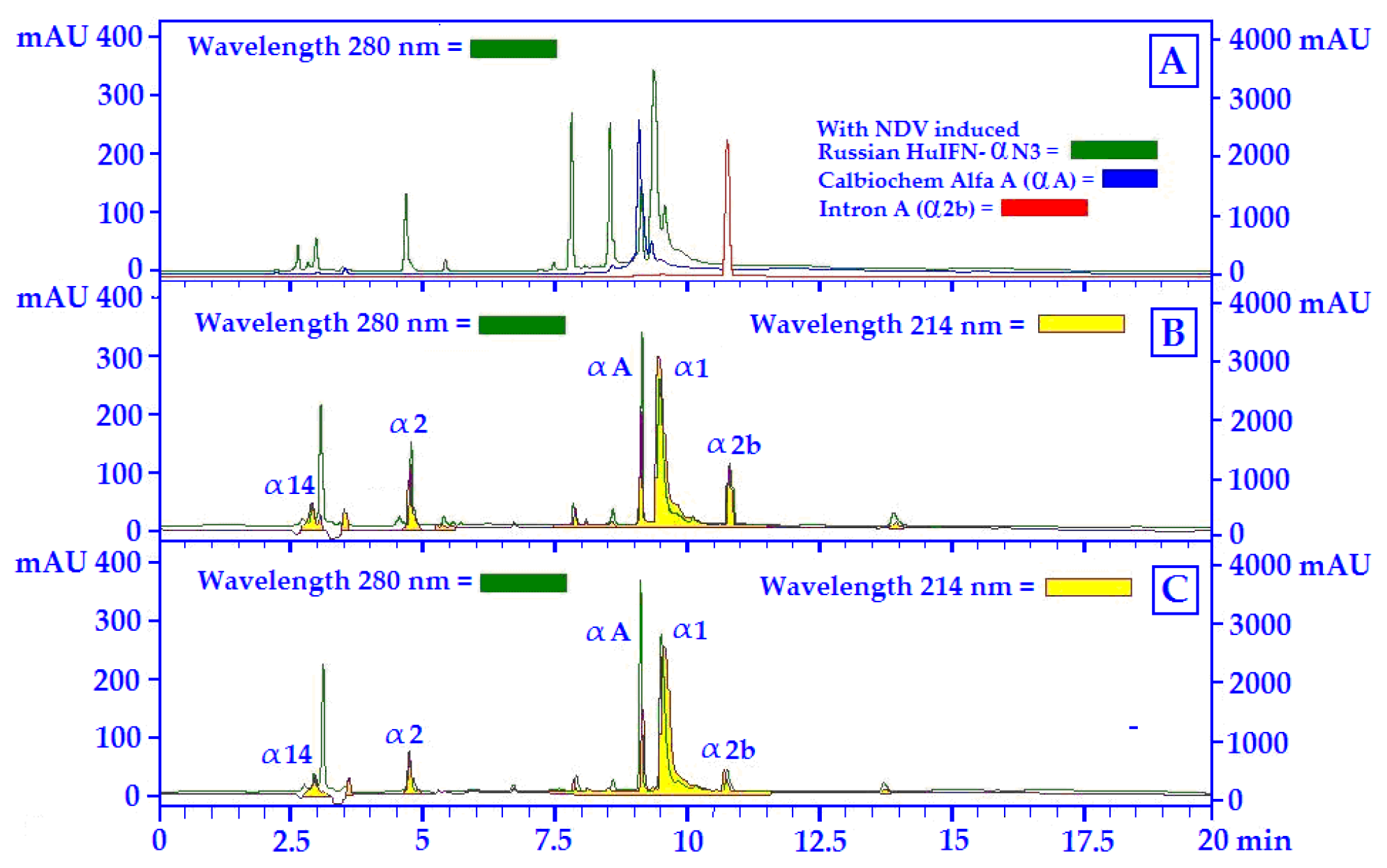The Enhancing Effects of 10% PBS Washout of Holocene Minerals on HuIFN-αN3 Inducing Capacity of NDV ZG1999HDS or Sendai virus (Cantell Strain)
Abstract
:1. Introduction
2. Material and Methods
2.1. Viruses
2.2. 10% PBS Washout of HM and Analysis of 10% PBS Washout of HM Crystals
2.3. The Isolation of Peripheral Blood Mononuclear Cells (PBMC) from Human Buffy Coats
2.4. The Determination of the Haemmaglutination (HA) Activity of the Strain of NDV ZG1999HDS and SV (Cantell Strain)
2.5. The Induction of HuIFN-αN3 with the Strain of NDV ZG1999HDS or SV (Cantell Strain)
2.6. HuIFN-αN3 Induction Enhancement Experiments
2.7. HuIFN-αN3 Monoclonal ELISA, (“Platinum ELISA”)
2.8. HuIFN-αN3 RP-HPLC Analysis
2.9. NO Assay
2.10. Lysozyme Determination
2.11. Statistics
2.12. The Plan of the Experiments
3. Results
3.1. HuIFN-αN3′s Induction Capacity of NDV ZG1999HDS or SV (Cantell Strain)
3.2. HuIFN-αN3 Enhancement Induction Experiments with 10% PBS Washout of HM
3.2.1. HuIFN-αN3 Enhancement Induction Experiments with 10% PBS Washout of HM without Priming with 100 IU/mL of HuIFN-αN3
3.2.2. HuIFN-αN3 Enhancement Induction Experiments with 10% with PBS Washout of HM and Priming with 100 IU/mL of HuIFN-αN3
3.3. Macrophage’s Activation: NO Assay and Lysozyme Determination
3.4. The RP-HPLC Analyses of the Strain of NDV ZG1999HDS versus SV (Cantell Strain) Induced Interferon (HuIFN-αN3)
4. Discussion
5. Conclusions
Author Contributions
Funding
Acknowledgments
Conflicts of Interest
References
- Li, S.; Gong, M.; Zhao, F.; Shao, J.; Xie, Y.; Zhang, Y.; Chang, H. Type I Interferons: Distinct Biological Activities and Current Applications for Viral Infection. Cell. Physiol. Biochem. 2018, 51, 2377–2396. [Google Scholar] [CrossRef] [PubMed]
- Witting, M.C.; Cahalan, S.R.; Levenson, E.A.; Rabin, R.L. Shared and Unique Features of Human Interferon–Beta and Interferon-Alpha Subtypes. Front. Immunol. 2021, 11, 605673. [Google Scholar] [CrossRef] [PubMed]
- Bekisz, J.; Schmeisser, H.; Hernandez, J.; Goldman, N.D.; Zoon, K.C. Human Interferon Alpha, Beta and Omega—Mini Review. Growth Factors 2005, 22, 243–251. [Google Scholar] [CrossRef] [PubMed] [Green Version]
- Kalliolias, D.G.; Ivashkiv, B.L. Overview of the biology of type I interferons. Arthritis Res. Ther. 2010, 12 (Suppl. 1), S1–S9. [Google Scholar] [CrossRef] [PubMed] [Green Version]
- Donnelly, P.R.; Kotenko, V.S. Interferon-Lambda: A New Addition to an Old Family. J. Interferon Cytokine Res. 2010, 30, 555–564. [Google Scholar] [CrossRef] [PubMed] [Green Version]
- Wheelock, E.F. Virus Replication and High-titered Interferon Production in Human Leukocyte Cultures Inoculated with Newcastle Disease Virus. J. Bacteriol. 1966, 92, 1415–1421. [Google Scholar] [CrossRef] [PubMed] [Green Version]
- Lee, H.S.S. Interferon Production by Human Leukocytes in vitro: Some Biological Characteristics. Appl. Microbiol. 1969, 18, 731–735. [Google Scholar] [CrossRef] [PubMed]
- Zeng, J.; Fournier, P.; Schirrmacher, V. Stimulation of human natural interferon response via paramyxovirus hemagglutinin lectin-cell interaction. J. Mol. Med. 2002, 80, 443–451. [Google Scholar] [CrossRef] [PubMed]
- Zeng, J.; Fournier, P.; Schirrmacher, V. Induction of interferon-alpha and tumor necrosis factor—related apoptosis-inducing ligand in human blood mononuclear cells by hemagglutinin-neuraminidase but not F protein of Newcastle disease virus. Virology 2002, 297, 19–30. [Google Scholar] [CrossRef] [Green Version]
- Mazija, H. Pneumotropic Lenthogenic Strain of Newcastle Disease Virus ZG1999HDS Isolated in Croatia. Republic of Croatia. State Intellectual Property Office of Croatia (In Croatian). Patent Application P20100579A, 2011. [Google Scholar]
- Nedeljković, G. Comparison of Cell–Mediated Immune Response Stimulated by Oculonasal Application of Newcastle Disease Virus Strain ZG1999HDS and Vaccines strain La Sota in Four Weeks Old Chickens. Ph.D. Dissertation, Veterinary Faculty, University of Zagreb, Zagreb, Croatia, 2014. [Google Scholar]
- Collection National de Cultures de Microorganismes (CNCM). Virus NDV ZG1999HDS is deposited at “Collection Nationale de Cultures de Microorganismes (CNCM)”; Accession No.: CNCM I-4811; Institut Pasteur: Paris, France, 2013. [Google Scholar]
- Anonymous. GeneBank. The Sequence Data Were Deposited in the Gene Bank under the Accession No: NDV_ZG1999HDS.sqn NDV_Zagreb_1999\Consensus KJ670427; Bethesda: Rockville, MD, USA, 2014. [Google Scholar]
- Biđin, M.; Mazija, H. Immunogenicity of field strain of Newcastle disease virus ZG2000 applied to SPF chickens. In Proceedings of the VIII Symposium Poultry Days 2009, Poreč, Croatia, 25–28 March 2009; pp. 241–245. (In Croatian). [Google Scholar]
- Nedeljković, G. Genomic Characterisation and Phylogenetic Analysis of Newcastle Disease Virus Isolate ZG1999HDS from the Outbreak in 1999 in Croatia. Master’s Thesis, Uppsala Universitet, Uppsala, Sweden, 2011. [Google Scholar]
- Filipič, B.; Šooš, E.; Mazija, H.; Koren, S. Human Interferon-α, and Holocene grain washout affects the growth of neoplastic cells in vitro. In Proceedings of the 5th International Conference on Tumor Microenvironment: Progression, Therapy and Prevention, Versailles, France, 20–24 October 2009; p. S171. [Google Scholar]
- Filipič, B.; Mazija, H.; Miko, S.; Šooš, E.; Koren, S. Human interferon –α and 10% PBS Holocene grain washout affect the growth and apoptosis of CaCo—2 cells in vitro. In Proceedings of the 7th Conference on Experimental and Translational Oncology, Portorož, Slovenia, 20–24 April 2013; Book of Abstracts. p. S116. [Google Scholar]
- Smith, O.C. Identification and Qualitative Chemical Analysis of Minerals; University of California: California, CA, USA, 1953. [Google Scholar]
- Jarekrans, M.; Olovsson, H. Methionine Containing Animal Cell Culture Medium and Its Use. U.S. Patent 6,309,862B1, 2001. [Google Scholar]
- Atabekov, I.G. General Virological Practical Course. Experiment 3: Determination of the Virus Titer Using the Hemagglutination Reaction; Edition of the Moscow University; Moscow University: Moscow, Russia, 1981; pp. 16–18. (In Russian) [Google Scholar]
- Anonymous. Human IFN-α Platinum ELISA (BMS 216/BMS 216TEN); Affymetrix, Biosciences: Santa Clara, CA, USA, 2010. [Google Scholar]
- Alm, G.; Kauppinen, H.-L.; Parkkinen, J.; Tolo, H. Alpha-Interferon Manufacturing Process Using Immuno-Adsorbtion and Virus Removal Filtration. Australian Patent AU4783599A, 30 December 1999. [Google Scholar]
- Wang, T.; Ma, W.; Chen, Y.; Liu, L. Method to Detect and Treat Diseases. U.S. Patent US 2015/0283318 A1, 8 October 2015. [Google Scholar]
- More, P.; Pai, K. Immunomodulatory effects of Tinospora cordifolia (Guduchi) on macrophage activation. Biol. Med. 2011, 3, 134–140. [Google Scholar]
- Nash, A.; Ballard, S.N.T.; Weaver, T.E.; Akinbi, T.H. The Peptydoglycan Degrading Property of Lysozyme is not Requiered for Bactericidal activity in Vivo. J. Immunol. 2006, 177, 519–526. [Google Scholar] [CrossRef] [PubMed] [Green Version]
- Punainen, S.; Veripavel, U.R.; Tőlő, H.; Parkkinen, J. Alpha Interferon Manufacturing Process Using Immuno-Adsorbtion and Virus Removal Filtration. Patent No. WO 99/64440, 16 December 1999. [Google Scholar]
- Testa, D.; Liao, M.J.; Katalin, F.; Rashidbaigi, A.; Di Paola, M. Composition Containing Human Alpha Interferon Species Proteins and Method for Use Thereof. U.S. Patent No. 5,676,942, 14 October 1997. [Google Scholar]
- Fournier, P.; Schirrmacher, V. Oncolytic Newcastle Disease Virus as Cutting Edge between Tumor and Host. Biology 2013, 2, 936–975. [Google Scholar] [CrossRef] [PubMed] [Green Version]
- Židovec, S.; Mažuran, R. Sendai virus induces various cytokines in human peripheral blood leukocytes: Different susceptibility of cytokine molecules to low pH. Cytokine 1999, 11, 140–143. [Google Scholar] [CrossRef] [PubMed]
- Salunkhe, S.S.; Prasad, B.; Sabnis-Prasad, K.; Apte-Deshpande, A.; Padmaanabhan, S. Expression and purification of SAK—fused Human Interferon Alpha in Escherichia coli. J. Microbial. Biochem. Technol. 2009, 1, 5–10. [Google Scholar] [CrossRef]
- Iwata, H.; Tagaya, M.; Matsumoto, K.; Miyadi, T.; Yokochi, T.; Kimura, T. Aerosol vaccination with Sendai virus ts mutant (HVJ-pB) derived from persistently infected cells. J. Infect. Dis. 1990, 162, 402–407. [Google Scholar] [CrossRef] [PubMed]
- Antonelli, G. Biological basis for a proper clinical application of alpha interferons. New Microbiol. 2008, 31, 305–318. [Google Scholar] [PubMed]
- Carglia, M.; Libroa, A.M.; Corradino, S.; Coppola, V.; Guarrasi, R.; Barile, C.; Genua, G.; Bianco, R.A.; Tagliaferri, P. α-Interferon induces depletion of intracellular iron content and upregulation of functional transferring receptors on Human Epidermis cancer KB cells. Biochem. Bophys. Res. Commun. 1994, 203, 281–288. [Google Scholar] [CrossRef] [PubMed]
- Zoll, J.; Melchers, W.J.G.; Galama, J.M.D.; van Kuppeveld, F.J.M. The Mengovirus Leader Protein Suppress Alpha/Beta Interferon Production by Inhibition of the Iron/Ferritin Mediated Activation of NF-κβ. J. Virol. 2002, 76, 9664–9672. [Google Scholar] [CrossRef] [PubMed] [Green Version]
- Strahle, L.; Garcin, D.; Kolakovsky, D. Sendai virus defective-interfering genomes and the activation of interferon—beta. J. Virol. 2006, 351, 101–111. [Google Scholar] [CrossRef] [Green Version]
- Riedelberger, M.; Penninger, P.; Tscherner, M.; Seifert, M.; Jenull, S.; Brunnhofer, C.; Scheidl, B.; Irina Tsymala, I.; Bourgeois, C.; Petryshyn, A.; et al. Type I Interferon Response Dysregulates Host Iron Homeostasis and Enhances Candida glabrata Infection. Cell Host Microbe 2020, 27, 454–466. [Google Scholar] [CrossRef] [Green Version]
- Cheknyov, S.B.; Babayants, A.A.; Denisova, E.A. Induction of Interferon Production by Conformation—Modified Proteins of Plasma γ-Globulin Fraction. Bull. Exp. Biol. Med. 2008, 146, 591–595. [Google Scholar] [CrossRef] [PubMed]
- Bartneck, M.; Keul, H.A.; Singh, S.; Czaja, K.; Bornemann, C.; Bockstaller, M.; Moeller, M.; Zwadlo-Klarwasser, G.; Groll, J. Rapid Uptake of Gold Nanorods by Primary Human Blood Phagocytes and Immuno—modulatory Effects of Surface Chemistry. ACS Nano 2010, 4, 30. [Google Scholar] [CrossRef] [PubMed]




 ) and IFN profile at 214 nm (
) and IFN profile at 214 nm (  ) of HuIFN-αN3 induced with 100 HA/mL of NDV ZG1999HDS; (C) Protein profile at 280 nm (
) of HuIFN-αN3 induced with 100 HA/mL of NDV ZG1999HDS; (C) Protein profile at 280 nm (  ) and IFN profile at 214 nm (
) and IFN profile at 214 nm (  ) of HuIFN-αN3 induced with 100 HA/mL NDV ZG1999HDS + 10% PBS washout of HM.
) of HuIFN-αN3 induced with 100 HA/mL NDV ZG1999HDS + 10% PBS washout of HM.
 ) and IFN profile at 214 nm (
) and IFN profile at 214 nm (  ) of HuIFN-αN3 induced with 100 HA/mL of NDV ZG1999HDS; (C) Protein profile at 280 nm (
) of HuIFN-αN3 induced with 100 HA/mL of NDV ZG1999HDS; (C) Protein profile at 280 nm (  ) and IFN profile at 214 nm (
) and IFN profile at 214 nm (  ) of HuIFN-αN3 induced with 100 HA/mL NDV ZG1999HDS + 10% PBS washout of HM.
) of HuIFN-αN3 induced with 100 HA/mL NDV ZG1999HDS + 10% PBS washout of HM.
 ) and IFN profile at 214 nm (
) and IFN profile at 214 nm (  ) of HuIFN-αN3 induced with 100 HA/mL of SV; (C) Protein profile at 280 nm (
) of HuIFN-αN3 induced with 100 HA/mL of SV; (C) Protein profile at 280 nm (  ) and IFN profile at 214 nm (
) and IFN profile at 214 nm (  ) of HuIFN-αN3 induced with 100 HA/mL SV + 10% PBS washout of HM.
) of HuIFN-αN3 induced with 100 HA/mL SV + 10% PBS washout of HM.
 ) and IFN profile at 214 nm (
) and IFN profile at 214 nm (  ) of HuIFN-αN3 induced with 100 HA/mL of SV; (C) Protein profile at 280 nm (
) of HuIFN-αN3 induced with 100 HA/mL of SV; (C) Protein profile at 280 nm (  ) and IFN profile at 214 nm (
) and IFN profile at 214 nm (  ) of HuIFN-αN3 induced with 100 HA/mL SV + 10% PBS washout of HM.
) of HuIFN-αN3 induced with 100 HA/mL SV + 10% PBS washout of HM.
| Analyte: | UNIT: | MDL: | Sample: | Analyte: | UNIT: | MDL: | Sample: |
|---|---|---|---|---|---|---|---|
| SiO2 | % | 0.01 | 88.71 | La | PPM | 0.1 | 12.7 |
| Al2O3 | % | 0.01 | 5.37 | Pr | PPM | 0.02 | 2.95 |
| Fe2O3 | % | 0.04 | 1.08 | Nd | PPM | 0.3 | 11.0 |
| MgO | % | 0.01 | 0.44 | Sm | PPM | 0.05 | 2.22 |
| CaO | % | 0.01 | 0.66 | Eu | PPM | 0.02 | 0.47 |
| Na2O | % | 0.01 | 1.41 | Gd | PPM | 0.05 | 2.19 |
| K2O | % | 0.01 | 0.92 | Tb | PPM | 0.01 | 0.33 |
| TiO2 | % | 0.01 | 0.18 | Dy | PPM | 0.05 | 1.89 |
| P2O5 | % | 0.01 | 0.12 | Ho | PPM | 0.02 | 0.42 |
| MnO | % | 0.01 | 0.02 | Er | PPM | 0.03 | 1.08 |
| Cr2O3 | % | 0.002 | 0.004 | Tm | PPM | 0.01 | 0.18 |
| Ni | % | 20.0 | <20.0 | Yb | PPM | 0.05 | 1.27 |
| Sc | % | 1.0 | 3.0 | Lu | PPM | 0.01 | 0.19 |
| Ba | PPM | 1.0 | 154.0 | Mo | PPM | 0.1 | 0.4 |
| Be | PPM | 1.0 | <1.0 | Cu | PPM | 0.1 | 5.0 |
| Co | PPM | 0.2 | 2.8 | Pb | PPM | 0.1 | 5.8 |
| Cs | PPM | 0.1 | 1.1 | Zn | PPM | 1.0 | 17.0 |
| Ga | PPM | 0.5 | 5.4 | Ni | PPM | 0.1 | 11.4 |
| Hf | PPM | 0.1 | 3.6 | As | PPM | 0.5 | 1.9 |
| Nb | PPM | 0.1 | 5.0 | Cd | PPM | 0.1 | <0.1 |
| Rb | PPM | 0.1 | 36.1 | Sb | PPM | 0.1 | 0.1 |
| Sn | PPM | 1.0 | <1.0 | Bi | PPM | 0.1 | 0.3 |
| Sr | PPM | 0.5 | 75.4 | Ag | PPM | 0.1 | <0.1 |
| Ta | PPM | 0.1 | 0.6 | Au | PPM | 0.5 | 12.1 |
| Th | PPM | 0.2 | 4.6 | Hg | PPM | 0.01 | 0.01 |
| U | PPM | 0.1 | 1.2 | Ti | PPM | 0.1 | <0.1 |
| V | PPM | 8.0 | 11.0 | Se | PPM | 0.5 | <0.5 |
| W | PPM | 0.5 | 1.3 | LOI | % | 5.1 | 1.1 |
| Zr | PPM | 0.1 | 131.0 | TOT/C | % | 0.02 | 0.12 |
| Y | PPM | 0.1 | 12.2 | TOT/S | % | 0.2 | <0.02 |
| Ce | PPM | 0.1 | 25.2 | Summa | % | 0.01 | 99.7 |
| 10% HM–PBS Crystals | ||
|---|---|---|
| Analytes | Absolute Values | Relative Values |
| LaCe | 3.0 | 0.336 |
| Fe2+ | 129.0 | 14.478 |
| Sb | 0 | 0 |
| Ba | 0 | 0 |
| Pb | 1.0 | 0.112 |
| BaAl | 21.0 | 0.112 |
| BaCaSi | 3.0 | 0.337 |
| SiKCa++ | 67 | 7.512 |
| K | 68.7 | 77.104 |
| Au | 1.0 | 0.168 |
| Summa | 891 | 100 |
| Summa absolute | 909 | |
| Step | Time (Minutes) | Solvent A | Solvent C |
|---|---|---|---|
| 0 | 0 | 91 | 9 |
| 1 | 3 | 80 | 20 |
| 2 | 6 | 50 | 50 |
| 3 | 12 | 50 | 50 |
| 4 | 15 | 91 | 9 |
| 5 | 20 | 91 | 9 |
| Induction with (1) NDV ZG1999HDS | The Amount of HuIFN-αN3 (pg/mL) | The Amount of HuIFN-αN3 (pg/mL) | Induction with SV (2) (Cantell Strain) |
|---|---|---|---|
| 3.6 HA/mL (3) | 435.12 ± 3.9 | 275.22 ± 6.8 | 3.6 HA/mL (3) |
| +10%PBS washout of HM | 3045.32 ± 30.2 | 1925.34 ± 22.6 | +10% PBS washout of HM |
| 6.4 HA/mL (3) | 283.49 ± 7.6 | 258.11 ± 6.2 | 6.4 HA/mL (3) |
| +10%PBS washout of HM | 1698.22 ± 11.3 | 1806.43 ± 12.9 | +10% PBS washout of HM |
| 9.6 HA/mL (3) | 295.32 ± 8.6 | 325.43 ± 3.4 | 9.6 HA/mL (3) |
| +10%PBS washout of HM | 2065.46 ± 58.2 | 2275.43 ± 65.3 | +10% PBS washout of HM |
| 100 HA/mL (3) | 483.23 ± 4.5 | 584.16 ± 5.9 | 100 HA/mL (3) |
| +10%PBS washout of HM | 3818.21 ± 41.9 | 4790.34 ± 33.5 | +10% PBS washout of HM |
| Induction with (1) NDV ZG1999HDS | The Amount of HuIFN-αN3 (pg/mL) | The Amount of HuIFN-αN3 (pg/mL) | Induction with SV (2) (Cantell Strain) |
|---|---|---|---|
| NDV ZG1999HDS 100 HA/mL (3) | 483.23 ± 4.5 | 584.16 ± 5.9 | SV(Cantell strain) 100 HA/mL |
| NDV ZG1999HDS 100 HA/mL + 10% PBS washout of HM(4) | 3818.21 ± 41.9 | 4790.34 ± 33.5 | SV(Cantell strain) 100 HA/mL + 10% PBS washout of HM |
| HuIFN-αN3 100 IU/107 PBMCs (5) + NDV ZG1999HDS 100 HA/mL | 2695.10 ± 22.4 | 3447.29 ± 47.3 | HuIFN-αN3 100 IU/107 PBMCs + SV(Cantell strain) 100 HA/mL |
| HuIFN-αN3 100 IU/107 PBMCs + NDVZG1999HDS 100 HA/mL + 10% PBS washout of HM | 772.12 ± 9.2 | 442.24 ± 1.3 | HuIFN-αN3 100 IU/107 PBMCs + SV(Cantell strain) 100 HA/mL + 10% PBS washout of HM |
| Samples: | The Amount of HuIFN-αN3 (pg/mL) | The Amount of Nitrite (NO) (μM/mL) | The Amount of Lysozyme (μM/mL) |
|---|---|---|---|
| NDV(1) ZG1999HDS 100HA (3) | 483.23 ± 4.5 | 7.2 ± 1.8 | 15.0 ± 1.4 |
| NDV ZG1999HDS 100HA (3) + 50 mM FeCl2 | 25.05 ± 0.4 | 6.4 ± 0.9 | 15.4 ± 2.8 |
| NDV ZG1999HDS 100HA (3) + 50 mM FeCl3 | 320.27 ± 4.9 | 11.6 ± 3.5 | 9.4 ± 2.5 |
| NDV ZG1999HDS 100HA (3) + 50 mM KCl | 232.12 ± 8.1 | 10.16 ± 2.7 | 7.6 ± 1.8 |
| SV(2) (Cantell strain) 100HA (3) | 584.16 ± 5.9 | 8.6 ± 1.7 | 11.7 ± 2.4 |
| SV (Cantell strain) 100HA (3) + 50 mM FeCl2 | 23.0 ± 0.8 | 6.9 ± 0.35 | 9.2 ± 0.72 |
| SV (Cantell strain) 100HA (3) + 50 mM FeCl3 | 250.46 ± 1.6 | 10.4 ± 2.1 | 9.6 ± 0.11 |
| SV (Cantell strain) 100HA (3) + 50 mM KCl | 272.33 ± 2.4 | 8.6 ± 1.4 | 9.7 ± 1.7 |
| Untreated PBMCs (4) | 18.7 ± 3.3 | 11.6 ± 2.4 | 10.2 ± 1.4 |
Publisher’s Note: MDPI stays neutral with regard to jurisdictional claims in published maps and institutional affiliations. |
© 2022 by the authors. Licensee MDPI, Basel, Switzerland. This article is an open access article distributed under the terms and conditions of the Creative Commons Attribution (CC BY) license (https://creativecommons.org/licenses/by/4.0/).
Share and Cite
Filipič, B.; Gradišnik, L.; Pereyra, A.; Mršić, G.; Andrašec, M.; Mazija, H. The Enhancing Effects of 10% PBS Washout of Holocene Minerals on HuIFN-αN3 Inducing Capacity of NDV ZG1999HDS or Sendai virus (Cantell Strain). Life 2022, 12, 414. https://doi.org/10.3390/life12030414
Filipič B, Gradišnik L, Pereyra A, Mršić G, Andrašec M, Mazija H. The Enhancing Effects of 10% PBS Washout of Holocene Minerals on HuIFN-αN3 Inducing Capacity of NDV ZG1999HDS or Sendai virus (Cantell Strain). Life. 2022; 12(3):414. https://doi.org/10.3390/life12030414
Chicago/Turabian StyleFilipič, Bratko, Lidija Gradišnik, Adriana Pereyra, Gordan Mršić, Marjan Andrašec, and Hrvoje Mazija. 2022. "The Enhancing Effects of 10% PBS Washout of Holocene Minerals on HuIFN-αN3 Inducing Capacity of NDV ZG1999HDS or Sendai virus (Cantell Strain)" Life 12, no. 3: 414. https://doi.org/10.3390/life12030414
APA StyleFilipič, B., Gradišnik, L., Pereyra, A., Mršić, G., Andrašec, M., & Mazija, H. (2022). The Enhancing Effects of 10% PBS Washout of Holocene Minerals on HuIFN-αN3 Inducing Capacity of NDV ZG1999HDS or Sendai virus (Cantell Strain). Life, 12(3), 414. https://doi.org/10.3390/life12030414







